Propagating Wandering Jew plants is exciting and rewarding for plant lovers. Regardless of your gardening expertise, diving into the art of Wandering jew propagation promises an enjoyable and satisfying experience. However, this page covers all the step-by-step procedures of propagating Wandering Jews (inch plant), from the plant’s silent features to solving common pitfalls. So, let’s dive in and discover the secrets of successfully breeding Wandering Jews.
Unveiling the Mystery of The Wandering jew plant
Before we get into the propagation process, it’s essential to explore the salient features of the Wandering jew plant. Wandering jew, scientifically known as Tradescantia zebrina, is a houseplant plant native to Mexico, Colombia, Central America, and the Pacific region. However, as a result of its tendency to trail or “wander,” Tradescantia zebrina is commonly referred to as a “Wandering Jew.”. It is commonly known as the “Inch Plant.”
It is famous for its vibrant purple, pink, white, and green leaves that make it a sensible addition to any indoor or outdoor garden.
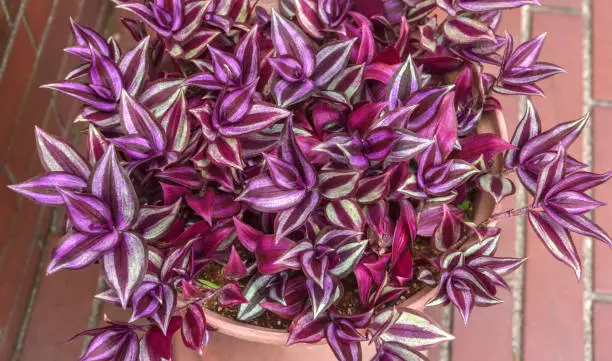
One of the amazing facts about it is that the silver inch plant is not an individual plant; instead, it serves as the collective name for a diverse range of Tradescantia species.
Moreover, with their easy-care nature, Wandering jew plants are an excellent choice for indoor/outdoor gardeners of all levels, whether seasoned or beginners. However, here’s its silent feature:
| Scientific Name | Common Name | Family | Plant Type | Sun Exposure | Soil Type | Soil pH | Height | Spacing | Bloom Time |
| Tradescantia spp | Wandering Jew | Commelinaceae | Perennial | Partial shade | Well-draining | 6.0 to 7.5 | 6 to 12 in | 12 to 18 in | Spring to Fall |
The information in the table is general, and nominal requirements may vary depending on the particular species of Tradescantia within the Wandering jew (Tradescantia zebrina) group.
Let’s dive into the magic of Wandering jew propagation and its techniques!
Benefits of propagating Wandering jew
There are several benefits to propagating Tradescantia zebrina plants. However, these benefits include;
Multiply Your Wandering jew plants Collection
The propagation of Wandering jew plants (T. zebrina) can rejuvenate older specimens and transform them into new plants that flourish in your indoor garden.
Cost-effective
You can spend a lot of money on a silver-inch plant, especially if you want to purchase a large one. Propagating Inch Plant is a cost-effective way to get more plants, and you will have a good return on your investment (ROI).
Healthy plants
As the plant grows mature and gets aging, there is a possibility that plants will lose their freshness and have more likelihood of getting pests and diseases. However, by propagating, newly planted plants have less chance of getting pests or diseases, saving you time and money. You can prune the plant back to a manageable size and encourage new growth by propagating it.
Easy to relocate
Are you thinking about moving to another place? Propagating Tradescantia zebrina plants is a highly recommended choice. Alternatively, to invest in a new one, you can relocate your old one or multiply its further branches. However, wandering jew houseplants (T. zebrina) are a great way to express your love of plants to family and friends.

Choosing the suitable technique for propagating Wandering jew
Wandering jew plants (T. zebrina) can be grown using various methods [1]Propagating Inch Plant in Soil. Read, including stem cuttings, division, water propagation, layering, air layering, offset, tissue culture, etc. However, each method has advantages and challenges, so choose the one that suits your requirements and the available resources.
- Stem Cuttings: Take 4-6 inch stem cuttings from healthy parent plants below a node. Remove lower leaves and place cuttings in a well-draining pot.
- Water Propagation: Place cuttings in a water container, ensuring nodes are submerged. Change the water regularly to prevent stagnation.
- Division: Divide mature Silver Inch plants with multiple stems and replant each section in separate pots.
- Layering: Encourage roots to develop by burying a section of the stem while still attached to the parent plant, then cut and replant once roots form.
- Offsets: Tradescantia zebrina produces offsets, baby plants growing near the base. Gently remove and plant them in their pots.
- Sphagnum Moss Propagation: Wrap the bottom of the stem cutting in moist sphagnum moss, wait for roots to develop, then transplant.
- Air Layering: Encourage root growth on a section of the stem by wrapping it with moist sphagnum moss and covering it with plastic wrap until roots form.
- Tissue Culture: Advanced method involving laboratory techniques to propagate plants from tissue samples. Best suited for experienced growers.
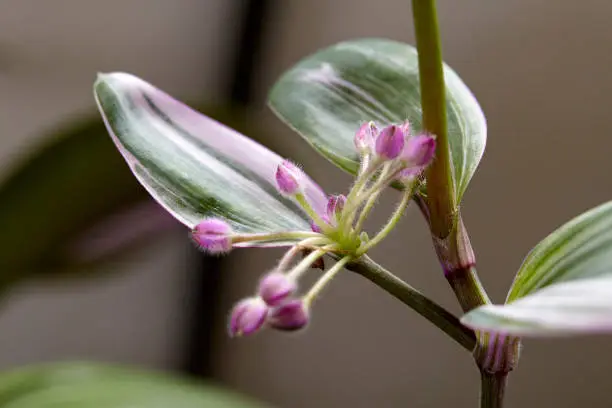
how to propagate Wandering jew using stem cutting approach
While stem cuttings are the most common method of propagating Wandering Jews (silver Inch plant), you can also explore other techniques, such as division and water propagation. However, Division Propagation involves separating the plant into smaller sections, each with its roots, while water propagation involves placing cuttings directly in water until roots form.
Here is a discussion on the most common and successful method: stem cuttings.
Multiply Your Wandering Collection with Stem Cuttings Propagation Techniques!
Materials Needed:
- Sharp scissors or pruners
- Clean container with water
- Rooting hormone (optional)
The procedure to propagate Wandering jew is straightforward. Here is how you can do it:
- Select Healthy Parent Plant – Choose a mature Wandering jew plant having no signs of disease or distress.
- Prepare the Cuttings – Take 4-6 inches (10 – 12 cm) stem cuttings with at least three to four nodes, making diagonal cuts just 1 inch (2.54 cm) below a node.
- Optional (Apply Rooting Hormone) – Dip the cut end of each stem into the rooting hormone for fasting root growth.
- Plant the Cuttings – Place the cuttings in water, ensuring nodes are submerged or well in contact with the soil.
- Provide Optimal Conditions: Keep the cuttings in a warm, light area, away from direct sunlight. Maintain a consistent temperature (60°F to 80°F (15.6°C to 26.7°C)) and humidity.
- Monitoring: Regularly noting and documenting root development. Maintain appropriate moisture levels carefully to avoid overwatering circumstances.
- Transplant Rooted Cuttings: After 2-6 weeks, once the cuttings have healthy roots, your plant is ready to transform to transplant them into individual pots with well-draining soil.
Following the above procedure, you can propagate Wandering jew plants using stem cuttings.
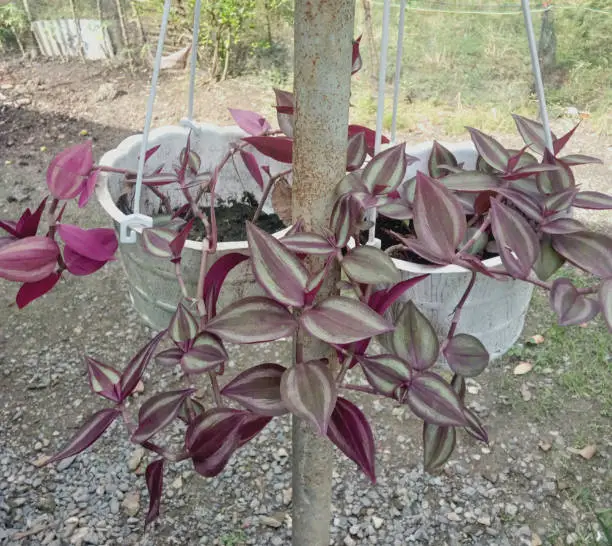
Discover the Tools and procedures You Need to propagate Wandering Jew
However, propagating Wandering jew (T. zebrina) is a straightforward procedure, and there are a few different approaches you can use depending on the resources and needs.
Here is the summarized note covering all the techniques of propagating the Inch plant (wandering jew Plant).
| Propagation Method | Materials Needed | Steps |
| Sphagnum Moss | Healthy stem cutting, moist sphagnum moss, plastic wrap | – Wrap stem cutting with moist moss. – Enclosed in plastic wrap. – Wait for roots to develop. – Transplant once roots form. |
| Water Propagation | Clean container, water, healthy stem cutting | – Place stem cutting in a water container, ensuring nodes are submerged. – Change the water regularly. – Wait for roots to grow. – Transplant when roots form. |
| Division Propagation | Mature Wandering jew plant with multiple stems, pots, soil | – Carefully divide the plant into separate stems. – Transplant each section into its pot. |
| Layering Propagation | Healthy stem attached to parent plant, soil, pots, plastic wrap | – Bury a section of the stem in the soil while attached to the parent plant. – Wait for roots to develop. – Cut and replant once roots form. |
| Offset Propagation | Parent Wandering jew plant with offsets, pots, well-draining soil | – Gently remove offsets from the parent plant. – Plant each offset in its pot. |
| Air Layering Propagation | Healthy stem attached to the parent plant, moist sphagnum moss, plastic wrap | – Wrap a section of the stem with moist moss. – Cover with plastic wrap. – Wait for roots to form. – Cut and transplant once roots develop. |
Read: Propagate Elephant Ear Plants: A Step-by-Step Guide
Best top-notch practices for propagating Wandering jew
To boost the likelihood of a successful rate when propagating Wandering jew plants, it’s essential to follow some best practices. Here are a few top-notch tips to keep in mind:
Timing
If you plan to propagate your plants during spring or summer, ensure they are actively growing; don’t propagate during the harsh winter months.
Healthy Parent Plants
Select parent plants free from pests, diseases, and stress to increase the likelihood of producing healthy cuttings.
Proper Cutting Technique
Make cuts just below a node above 1 inch (2.54 cm) and ensure each cutting has several nodes to promote optimal root development.
Optimal Environmental Conditions
Provide bright, indirect light, and maintain a warm and humid environment to boost healthy growth in the cuttings.
Patience and Monitoring
Be patient and consistent in monitoring and caring for the cuttings; minimize handling and disturbance during the rooting process.

Wandering jew Propagation Gone Wrong? Stay Aware of These Pitfalls!
While propagating Wandering jew plants (T. zebrina) is relatively straightforward, some common mistakes can hinder success. By avoiding these pitfalls, you can increase your likelihood of successfully multiplying Wandering Jews. These are common issues encountered while multiplying Wandering jew plants, their respective causes, and recommended solutions.
| Issue | Cause | Solution |
| Overwatering | Excessive watering | Maintain a balance between moisture and proper drainage to prevent root rot. |
| Insufficient Light | Inadequate light exposure | Place cuttings in a well-light area but avoid direct sunlight to prevent weak, poor growth. |
| Using Unhealthy Parent Plants | Propagating from unhealthy plants | Always choose healthy, well-developed parent plants to avoid propagating diseases or pests. |
| Improper Cutting Technique | Crushed or damaged stems while taking cuttings | Ensure cuts just below a node to promote healthy root development. |
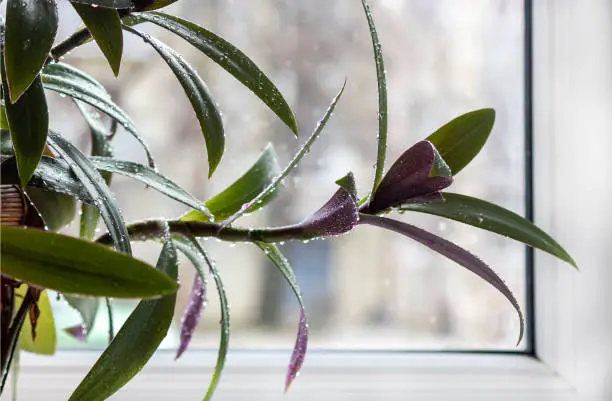
Read: Neon Pothos Propagation, Care, Benefits, and Problems
Checklist For the Wandering Jew Cuttings Issues
Sometimes, issues may arise during the propagation process despite your best efforts. Common Issues with Wandering Jew Cuttings:
1. Rot Cuttings: If your cuttings are rotting before rooting, it’s likely due to overwatering or poor drainage. Therefore, to prevent rot, adjust your watering routine and ensure proper drainage.
2. Wilting or Yellowing Leaves: Wilting or yellowing leaves may result from underwatering or excessive light exposure. However, Adjust the watering schedule.
3. Lack of Root Development: If your cuttings aren’t developing roots after several weeks, it may indicate insufficient warmth or humidity. Meanwhile, Increase the temperature and humidity around the cuttings to promote root growth.
Read: Daucus Carota (Queen Anne’s lace) types, propagation, and problems
Monitoring Checklist for newly propagated Wandering jew plants
Once your Wandering jew cuttings have successfully rooted and are ready for transplanting, providing proper care is crucial to ensure their continued growth and health. However, Here are some top-notch tips for monitoring newly propagated Wandering jew plants:
| Aspect | Requirements |
| Light | Bright indirect light; avoid direct sun to maintain vibrant colors in leaves and flowers. |
| Water | Water well, allowing the top 2″ to 3″ of soil to dry before watering; avoid overwatering to prevent root rot. |
| Fertilizer | Monthly feeding with diluted water-soluble houseplant food high in nitrogen for colorful leaves; avoid over-fertilizing. |
| Temperature | Thrives in temperatures between 60°F to 80°F (15.6°C to 26.7°C). |
| Humidity | Average to higher household humidity; place on wet pebbles to increase humidity without submerging the plant in water. |
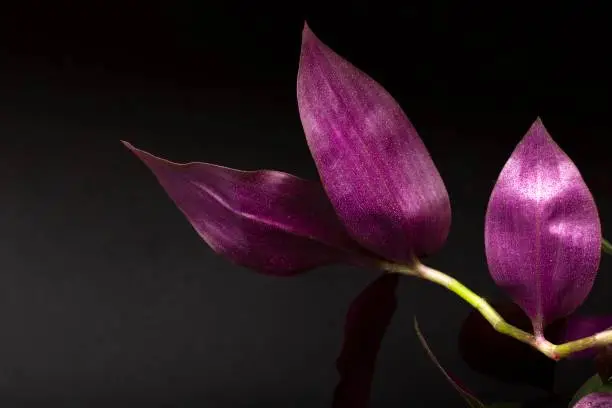
Conclusion
Following the step-by-step instructions and best practices outlined in this blog, you are well on your way to successfully propagating Wandering Jews (T. zebrina). However, monitor your cuttings regularly, provide optimal growing conditions, and be prepared to troubleshoot any issues. Remember, patience and care are key when propagating Wandering jew plants (silver inch plant). Therefore, with time and practice, you will become an expert at multiplying Wandering Jews and enjoy the beauty of these stunning plants.
So, get into the propagating journey, have fun, and experiment with different methods!



